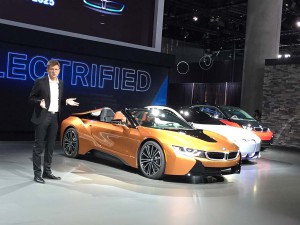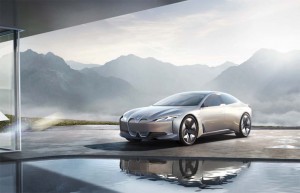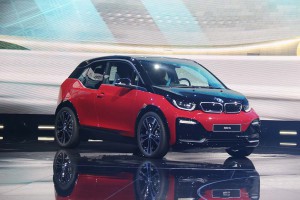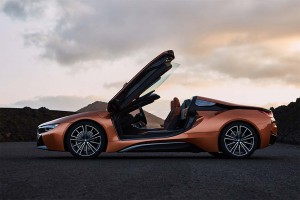BMW made headlines when it launched the industry’s first unique electrified vehicle sub-brand with the debut of its i3 and 15 models five years ago and its getting ready to expand the line-up with several new offerings, including a production version of the coupe-like i4 sedan that debuted at the Frankfurt Motor Show last autumn.
Set to reach showrooms by 2020, BMW CEO Harald Kruger said the i4 will offer a range of up to 435 miles per charge, nearly a third better than the industry’s current long-range champ, the Tesla Model S P100D – and more than triple what the all-electric i3 model today delivers. But the debut of the i4 will also mark another critical milestone for BMW’s push into electrification.
On Wednesday, as TheDetroitBureau.com reports in a separate story, BMW announced a major increase in spending on both electrified and autonomous vehicle programs. The i4 will be one of 25 electrified models by 2025, 12 of them pure battery-electric vehicles, or BEVs. According to an earlier statement by Kruger, “all fully-electric BMWs will belong to BMW i,” but, that said, there will be some major changes to that electric brand going forward. Most importantly, future products, like the i4, will no longer be based on unique, standalone platforms like those use for the i3 and 15 models.
Instead, BMW now plans to electrify the same platforms it uses for conventional gas-powered models, the CEO said this week. In other words, the i4 will use the same, underlying architecture as the gas-powered 4-Series models. So will all-electric versions of other conventional models, such as the X3.
(For more on BMW’s plans to up EV and AV spending, Click Here.)
The approach, Kruger explained during the BMW annual shareholders meeting in Germany, is an essential step in mainstreaming battery-based vehicles. Developing unique platforms radically increases the cost of models like the i3 city car and i8 plug-in hybrid sports car. Sharing platforms, the automaker believes, will sharply improve economies of scale.
There will need to be changes to the way BMW designs its vehicle platforms, however. During a recent background briefing in Palm Springs, company officials noted that future architectures will actually allow BMW to switch between two vehicle load floors. One of those will be designed specifically for electrified models and will provide space in the floor for battery packs – much in line with the way that Tesla Model S and the Chevrolet Bolt EV are today laid out.
That approach has several advantages. For one thing, it will minimize any intrusion into a vehicle’s passenger and cargo space, a drawback with many current electrified vehicles where batteries are tucked under seats or in the trunk. It also helps manage weight distribution. A 435-mile version of the i4 would likely need about 120 kilowatt-hours of lithium-ion batteries. While the technology is improving, that would still amount to somewhere near a 1,000-pound pack. The lower that mass goes the better the center of gravity, critical to maintaining BMW’s traditionally sporty driving dynamics.
While BMW hasn’t revealed much detail about which models will be electrified and when, it has offered a hint as to the breadth of its strategy which will include a mix of conventional hybrids, plug-ins and BEVs – pretty much every model the maker builds offered with at least one battery-based option.
To get there, the carmaker has developed a mix of modular motor drive systems that could be described as small, medium, large and extra-large. They will be able to be mixed and matched to provide front-wheel-drive, rear-drive or all-wheel-drive.
Any individual model will be able to use up to three packs, one in front and two in the rear, explained Tom Plucinsky, the head of technology communications, delivering up to a combined 750 kilowatts of power. That works out to about 1,000 horsepower, “which is M-car territory,” he suggested. In fact, due to the instant-on, high-torque of electric motors, it’s quite possible a future electric-M model will put today’s gas-powered versions to shame. BMW is estimating it could see 0 to 60 times of well under 3 seconds.
(Volvo’s standalone electric brand, Polestar, debuts its first model. Click Here to check it out.)
The current i8 model, which mixes a turbo-gas engine with multiple electric motors, uses a two-speed transmission. Going forward, Plucinsky noted, the plan is to rely on one-speed transmissions because of the incredible RPM range electric motors can operate at with great efficiency.
Those electric motors, meanwhile, will draw power from one of three modular battery packs now under development:
- A 60 kilowatt-hour pack expected to yield as much as 450 kilometers, or 280 miles, range;
- A 90 kWh pack delivering up to 550 km, or 342 miles, range; and
- A 120 kWh pack capable of up to 700 km, or 435 miles range – the pack expected to be used in the upcoming i4.

BMW mobility chief Klaus Froehlich with the new i8 Roadster, the Next Vision concept and the i3s at the LA Auto Show last November.
The modular platform approach should help drive down the cost of future electrified BMW models – especially as the price of batteries is expected to tumble sharply. At the beginning of the decade it cost about $1,000 per kilowatt-hour for lithium cells, a figure that is now under $200, according to a recent study by the Boston Consulting Group. BCG estimates that will hit around $70 by early in the coming decade and some experts forecast a figure as low as $50 if and when next-generation solid-state batteries come to market.
But there is still the challenge of charging, especially with the size of pack needed for 435 miles of range. Using a Level II 240-volt charger to “fill up” a completely empty battery could take a good part of a day, though most motorists are expected to plug in regularly, whether at home or office, or even when shopping. Still, the challenge is there to make all-electric models as flexible as the gas and diesel-powered vehicles of today.
BMW recently announced it will move to 150 kilowatt public chargers which, Plucinsky noted, “should be able to reduce charging times to a half-hour” for an 80% top-off. Even more advanced, so-called Level 4 chargers are under development and could cut times to less than 15 minutes.
Addressing cost, performance and charging challenges will be critical to ensuring there’s a market for the array of electric models BMW plans to have in its showrooms by the middle of the coming decade.
(Study finds auto suppliers strongly opposed to Trump Admin. rolling back U.S. mileage rules. Click Here for more.)



